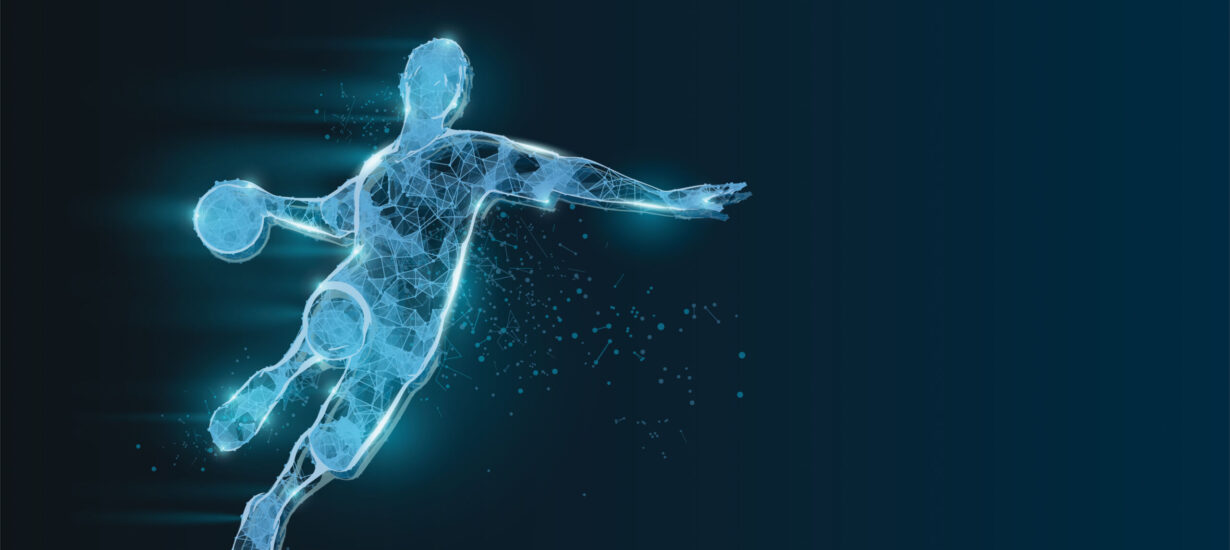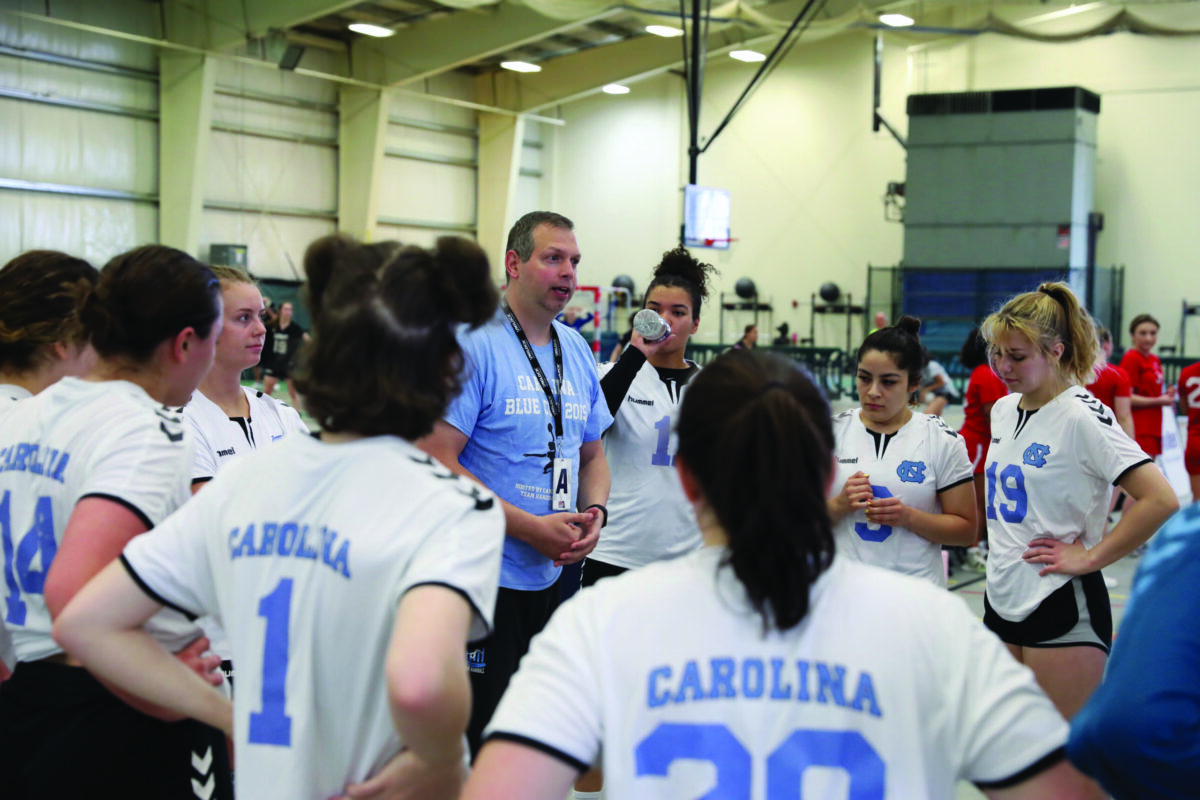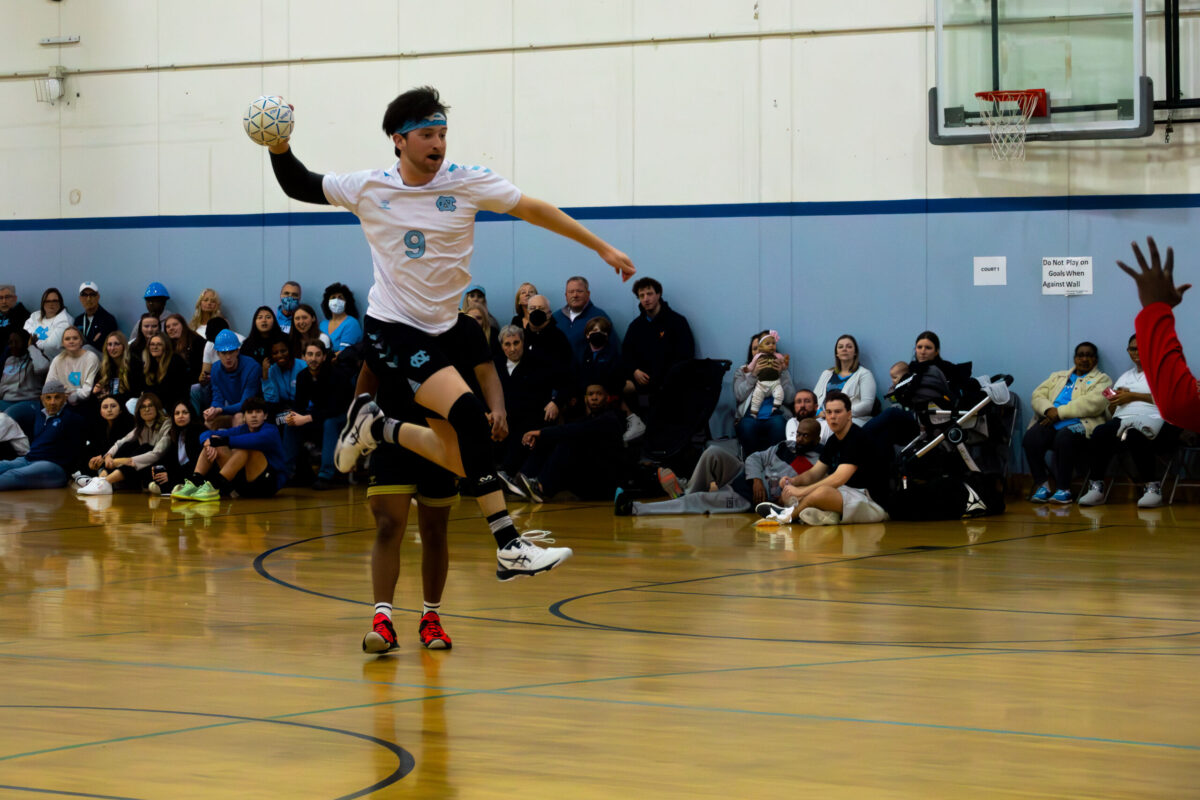A Totally Different Ball Game

Carolina just happens to have a few good teams in a sport you may have never heard of.
by Mark Derewicz
The ball sails over the goal, booming off a wall in Fetzer Gym. Six men scurry back on defense, while six players on the opposing team space themselves in a half-court offense, similar to how basketball players would set up to begin a play. The center back runs the offense like a point guard, moving the cantaloupe-size ball along the perimeter, taking a maximum-allowed three steps, then a dribble and three more steps. A pass over the top of the opposing players leads to an opening at the top of the key, as the speedy center back bursts through the defense, dribbles once and cuts toward the goal, jumping high and throwing the ball overhand as hard as he can. As he sails through the air, a defender swats at the ball and wallops him with a shoulder to the chest. He crashes to the ground as the ball soars past the goalie into the net. That’s a point, and, surprisingly, no foul.
This is handball. Think water polo without the water, or indoor lacrosse without the sticks. There are all kinds of skills, rules, tactics and nuances to this fast-paced game, but they have to be absorbed through experience. For now, know this: Handball is fun — and physical. And at Carolina, the team is one of the best in the country. In fact, all the Carolina club teams — the men’s and women’s and even the less-skilled B squads — are among the best.
“Our men’s B-team is probably the fourth or fifth best team in the country this year,” said former Carolina star player and current coach Aaron Hamm ’21. “And I think our A-team is better than West Point. But they’re better conditioned, for obvious reasons.”
Perennial powerhouse West Point has won the national championship for the past 16 consecutive years. But Hamm, ever the competitor, thought his Tar Heels could have dethroned the Black Knights in 2020 or 2021 if not for COVID canceling both seasons. In April 2022, the Tar Heels lost in the collegiate semifinals to Ohio State, and West Point won another natty. But in May that year, Carolina won the U.S. Open tournament, which includes college teams and club teams not associated with universities. The most recent collegiate tournament was The Carolina Blue Cup held on campus in February. Carolina’s alumni team finished second and the college A team placed fifth. In the national championships in the spring, Carolina lost in the championship game to West Point by just five points. The B team finished sixth.
With the season completed, for Hamm and seniors from last year’s squad, it’s now time to focus on growing the interest in the game.
“A bit of everything”
Team handball was invented in Germany more than 100 years ago as an alternative to football, or what Americans call soccer. Compared with Europe and South America, the United States is in handball infancy. There are only about 50 adult recreation teams across the country, stocked with former college athletes and older players just having fun. Fewer than 30 U.S. universities have teams, and just a dozen of them field active traveling squads. There are a handful of under-18 teams, such as those in San Francisco, New York, Chicago and the Washington, D.C., area.

Aaron Hamm ’21, coach of the men’s club team, wants to help younger athletes fall in love with handball like he did. And he wants to help Team USA embrace the American style of play — a fast-paced, slicing offense, which creates a constant threat to the defense. (Photo: Carolina Alumni/Cory Dinkel)
Hamm, a four-sport athlete-of-the-year award winner at Newton-Conover High School northwest of Charlotte, remembers seeing Olympic handball on TV as a kid. He never played until he came to Carolina at the beginning of his first year in 2017. By the end of his first year, Hamm had taken to the game and was so good that the U.S. Junior National Team selected him. A year later he was on the senior national team alongside the best players in the country, most of whom were born in the United States but now live in Europe.
Youth in Europe regularly play handball. A large number play the sport for years, and some — especially the taller and more physically gifted — make the cut for national teams or professional leagues.
Three of the top players on Carolina’s women’s team are from other countries — two from Chile, who don’t attend Carolina but live in Chapel Hill, and an exchange student from Denmark. They have instinctual movement on the court, not to mention wicked overhand throwing motions, adding zip to the ball as it soars toward the goal. Their American counterparts are getting there. They show fun and excitement learning a different sport than they knew growing up.
“Handball is the second or third most popular sport in Denmark, behind soccer, of course, and maybe tied with or just ahead of badminton,” said Carolina player and Denmark native Laura Hanson. “It’s exciting, and I’ve just always liked it more than other sports. I’ve been playing handball since I was six.” Her American teammates have been playing for only a few months. Their coach, Wade Sutton, played for Carolina in the 1990s, though he attended N.C. State University. He played on the national team for several years, and he has been involved as head coach or an assistant for the men’s and women’s teams for 20 years.
“I’ve always liked that handball is an interesting combination of sports — running, dribbling, throwing and physical contact,” Sutton said. “You have to play offense and defense. It’s very competitive.”
Carolina’s women’s team consists of about a dozen players, and the program has won a few national competitions since the club’s inception in 2001. The men’s team, which began in 1989, has more than 30 players this year and regularly wins events.

Coach Wade Sutton speaks with the women’s team, which consists of about a dozen players. Carolina’s women’s program has won a few national competitions since the club’s inception in 2001.
“A lot of us played sports in high school, and so handball is good competition,” says Zach Hudspeth ’22, a handball club officer whose responsibility was to keep the Carolina tradition of learning the game and then passing it on to new club members each fall. “When I started, the guys were really welcoming. All my best friends in college play it. And it’s just a really fun sport once you learn it.”
Hamm, one of the best players to come out of Carolina’s program, learned of the handball club at FallFest, part of UNC’s annual orientation event for first-year students. Ethan Peikes ’18 invited Hamm to give handball a try. He immediately fell in love with the game. “It has a bit of everything I like from all the sports I played all my life,” Hamm said.
Physically gifted with an athlete’s instincts and intellect, Hamm learned quickly from teammates and his coach Myles Bacon ’02. As he excelled and played in international events, Hamm learned the college style is not exactly in vogue around the world.
Basic Handball Rules
- A match consists of two periods of 30 minutes each.
- Each team has seven players: a goalkeeper and six outfield players.
- A team can have seven substitutes, which can enter a game on a rolling basis, with no need to notify the referee.
- Outfield players can touch the ball with any part of their body that is above the knee.
- Once a player receives possession, he or she can pass, hold possession or shoot.
- A player can dribble or take three steps for up to three seconds without dribbling.
- The 6-meter line delineates the goal area, where offensive and defensive players cannot stand. Players can jump into the area but must shoot or pass the ball prior to landing.
- After a foul, a player is awarded a free throw from the dotted line. All offensive players must start play behind the free-throw line.
- After a penalty, a shooting player must stand behind the penalty line and avoid touching or crossing the line when he or she shoots.
- During a penalty throw, the goalkeeper must stand behind the 4-meter restraining line.
- Goalkeepers are allowed out of the goal area but must not retain possession of the ball if they are outside the goal area.
Sources: teamhandballnews.com, rulesofsport.com
Passing up the pros
Up-tempo and intense, handball is a full-court game played in 30-minute halves, with scores usually totaling more than 40 goals a game. It’s also physically demanding, like competitive basketball, lacrosse and soccer.
Hamm, who was a research associate at the UNC Eshelman School of Pharmacy after graduating, received offers to play professionally in Europe. He considered it, but because of a string of injuries and a desire to become a dentist, Hamm chose to enroll in the UNC Adams School of Dentistry, where he plans to graduate in 2026.
Hamm says being a coach at Carolina and keeping connections to Team USA, the country’s top handball team that plays internationally, will allow him to help grow interest in the game in the United States. He wants to help younger athletes fall in love with handball like he did. And he wants to help Team USA embrace the American style of play — a fast-paced, slicing offense, which creates a constant threat to the defense, combined with an aggressive defense to combat the height of the best international players.

Europeans play a methodical style, relying on their height and jumping ability to create space above the defender to score. But most Americans, including college teams, play a more grounded game. They try to beat defenders one-on-one, relying on quickness and speed to find clear shooting lanes. Aaron Hamm ’21 said Team USA needs to commit to growing the game with players versed in the American style. (Photo: Carolina Alumni/Cory Dinkel)
Europeans play a more methodical style, relying on their height and jumping ability to create space above the defender to score. Hamm is 6 feet tall, can leap and possesses the athleticism and intelligence to be competitive in the European style. But most Americans, including college teams, play a more grounded game. They try to beat defenders one-on-one, relying on quickness and speed to find clear shooting lanes. Hamm is convinced the style can be successful, and Americans don’t need to field a squad of athletic 6-foot-7-inch studs.
“Right now, all the European-American guys on Team USA play the European style,” Hamm said. “I understand why, but that won’t fly long term.”
The players on the Japanese national team are not big and rely on speed to score and defend, and they still send their best players to play in Europe, Hamm said.
But Japan and their players — even those who go to Europe — are dedicated to playing their own style in international competitions. Right now, European-style players dominate Team USA, and the squad can’t beat the best of the European or South American teams. Hamm said the best European-style players are not on Team USA. “No one blames European-Americans for playing the European style,” he said.
But Hamm said, at some point Team USA must commit to growing the game with Americans and commit to players like himself, instead of asking him to switch between the American style while playing in college and the European style when he trains with Team USA.
“These comments won’t get me in trouble with Team USA,” Hamm said. “The team leaders agree. They know we need to develop our own American style of play to compete consistently.”
Handball has been an Olympic sport since 1972. Team USA has yet to qualify for the 2024 Paris Olympics — which it could do at the Pan American Games this fall — but it won’t need to qualify for the 2028 Los Angeles Games, due to the host-nation teams automatically qualifying. By then, Hamm might not be on the team, and that is OK with him.
“My goal when playing with Team USA was to help change the culture of handball in the U.S., to make it more mainstream,” Hamm said. “For me to get this far was all kind of luck.”
Hamm fell into handball because Carolina has a handball tradition second only to West Point. He wants more players to have opportunities. He would like to see Team USA inspire and help build youth programs and college clubs as a feeder system akin to the pro clubs in Europe, which develop players for national teams.
Team USA’s last appearance in the Olympics was in Atlanta in 1996, when Tar Heels John Keller ’88 and Steve Penn ’91 became the only UNC club sport athletes to become Olympians, according to Hamm. The U.S. team has never won a medal in handball; it’s one of five summer sports in which Americans have never medaled. (The others are badminton, table tennis, rhythmic gymnastics and trampoline.) A medal in handball is unlikely in 2028 as well.
Hamm sees no reason the United States team can’t compete internationally or the sport can’t increase in popularity. But it will take people like Hamm, Bacon, Sutton and dedicated club players and officers at Carolina and nationwide to increase the game’s popularity.
“We all love the game, and we see this sport in an artistic, beautiful way,” Hamm said. “It’s not just running fast and jumping high. There’s so much to it. But mostly, it’s just so much fun.”
Mark Derewicz is director of research and national news for UNC Health Communications and the UNC School of Medicine and a freelance writer living in Chatham County.
Thanks for reading the Carolina Alumni Review
Carolina Alumni members, sign in to continue reading.
Not yet a member? Become one today.
